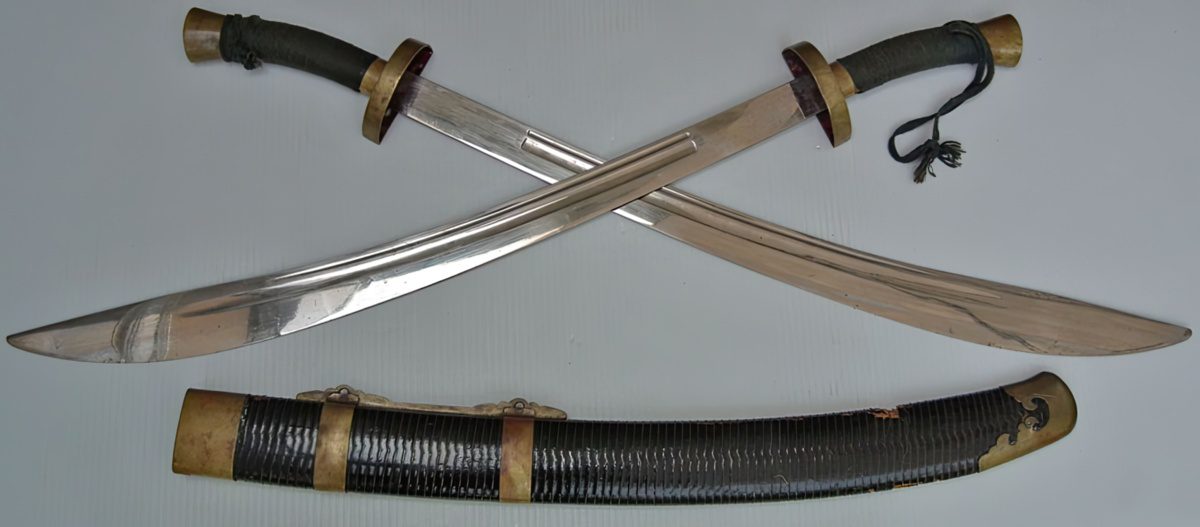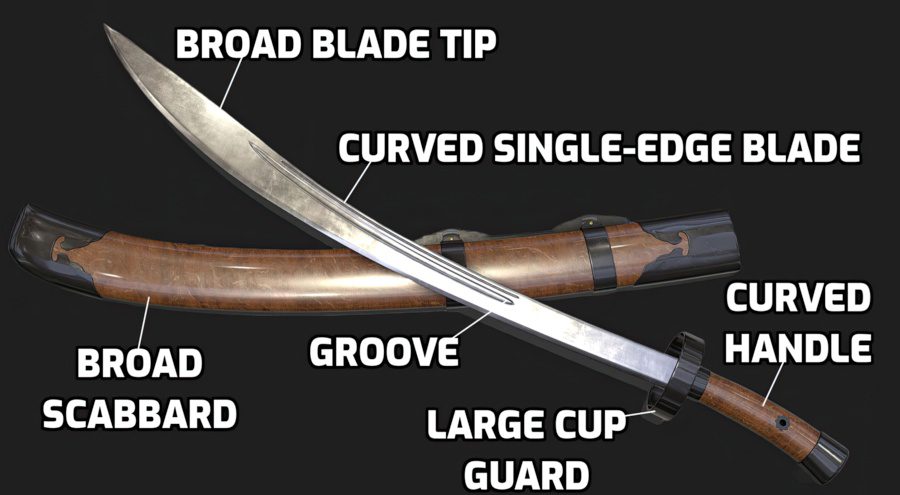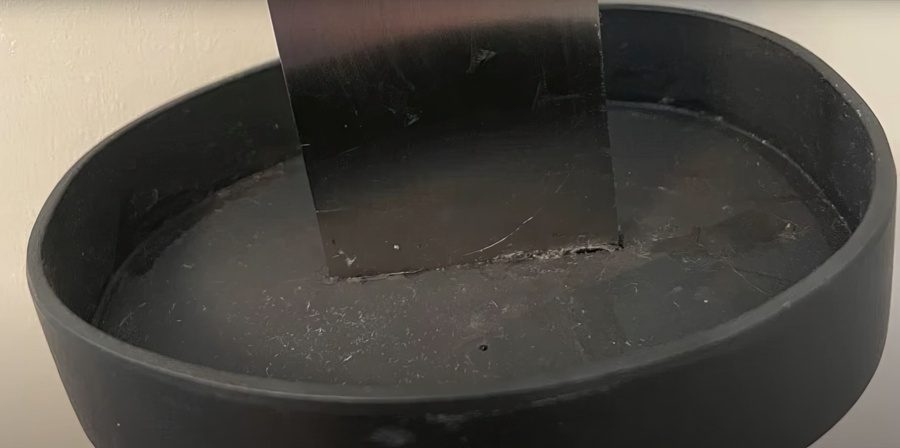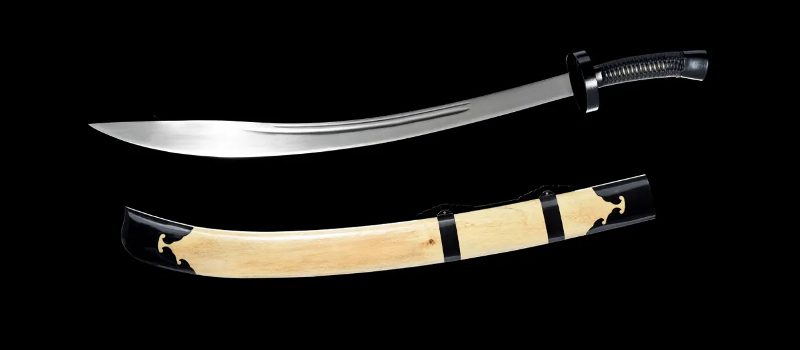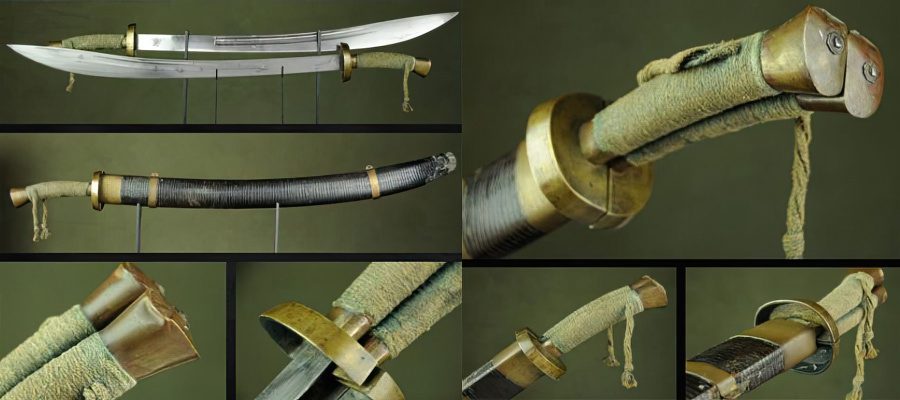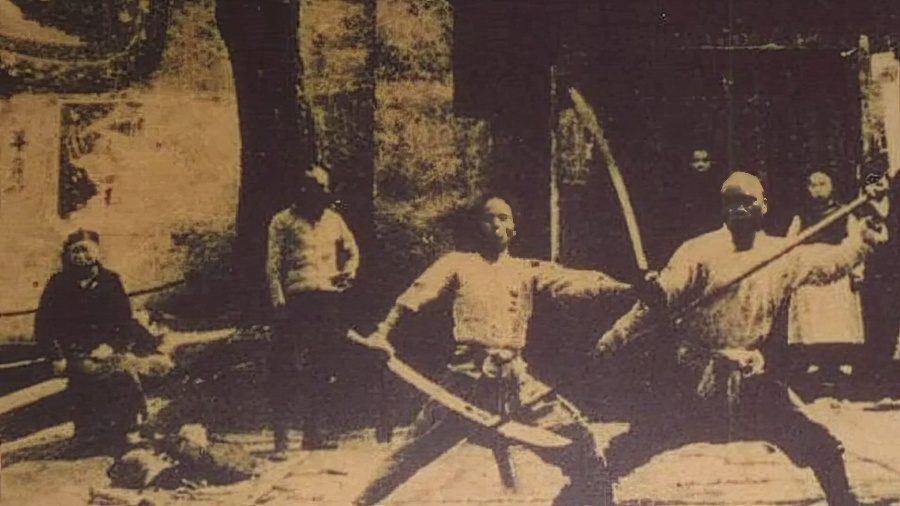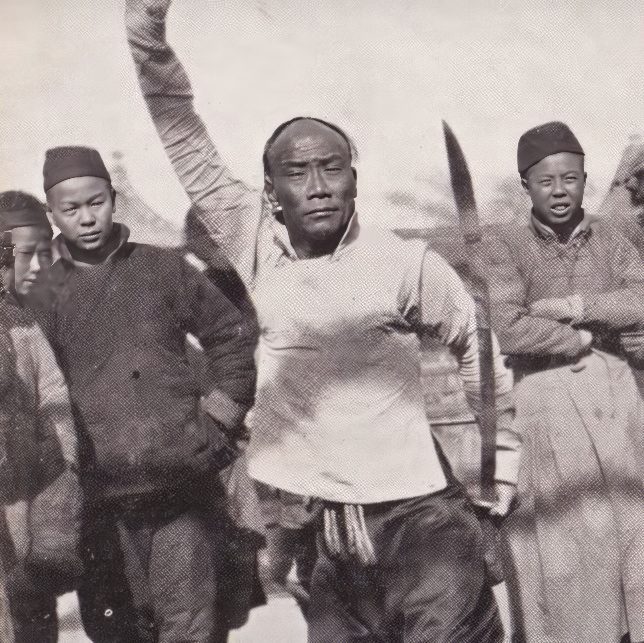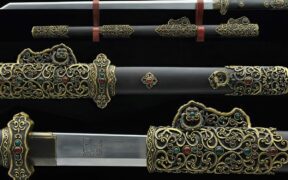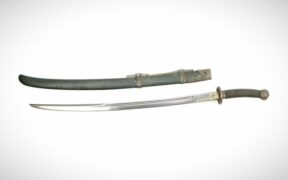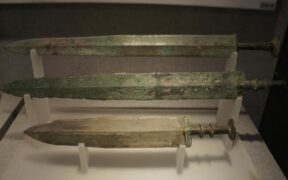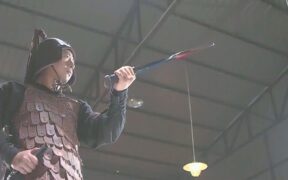u003colu003ern tu003cliu003eu003cspan data-sheets-root=u00221u0022 data-sheets-value=u0022{u0026quot;1u0026quot;:2,u0026quot;2u0026quot;:u0026quot;1. Culbertson, J. (2011, July 2). CHINESE SWORDS, Vol. I, Qing Dynasty.
1. Pegg, R., Yang, T., u0026amp; Figler, R. (2015, August 27). Chinese Swords: An Ancient Tradition and Modern Training.
1. Sprague, M. (2013, June 25). Chinese Swords: The Evolution and Use of the Jian and Dao.
1. Yang, J. M. (1999, March 9). Ancient Chinese Weapons: A Martial Arts Guide.
1. Zhang, Y. (2009, June 23). The Complete Taiji Dao: The Art of the Chinese Saber. Blue Snake.
1. Bennett, N. (2018, December 1). Chinese Arms and Armour. Books.
1. Burton, R. F. (2014, April 1). The Book of the Sword: A History of Daggers, Sabers, and Scimitars from Ancient Times to the Modern Day.
1. Chinese Swords: Chinese Swords, Seven-Branched Sword, Jian, Dao, Guan Dao, Hook Sword, Sword of Goujian, Taijijian, Butterfly Sword, Zhanmadao. (2010, May 1).
1. Chen, J. W. (2011, January 15). The Poetics of Sovereignty: On Emperor Taizong of the Tang Dynasty (Vol. 71).
1. Editorial Staff, B. E. (1998, May 1). Weapons and Warfare.
1. McNab, C. (2012, January 1). Knives and Swords. In A Visual History.
1. D. (2015, August 4). Military History. In The Definitive Visual Guide to the Objects of Warfare. DK.
1. Peterson, W. J. (Ed.). (2002, December 16). The Cambridge History of China: Vol. Vol. 9, Pt. 1.u0026quot;}u0022 data-sheets-userformat=u0022{u0026quot;2u0026quot;:513,u0026quot;3u0026quot;:{u0026quot;1u0026quot;:0},u0026quot;12u0026quot;:0}u0022u003eCulbertson, J. (2011, July 2). u003ca href=u0022https://books.google.com/books?id=FINMXwAACAAJu0026amp;dq=CHINESE+SWORDS,+Vol.+I,+Qing+Dynastyu0026amp;hl=enu0026amp;newbks=1u0026amp;newbks_redir=1u0026amp;sa=Xu0026amp;ved=2ahUKEwjWzJTRt56FAxU6RmwGHbCHD0UQ6AF6BAgGEAEu0022u003eCHINESE SWORDS, Vol. I, Qing Dynastyu003c/au003e.u003c/spanu003eu003c/liu003ern tu003cliu003eu003cspan data-sheets-root=u00221u0022 data-sheets-value=u0022{u0026quot;1u0026quot;:2,u0026quot;2u0026quot;:u0026quot;1. Culbertson, J. (2011, July 2). CHINESE SWORDS, Vol. I, Qing Dynasty.
1. Pegg, R., Yang, T., u0026amp; Figler, R. (2015, August 27). Chinese Swords: An Ancient Tradition and Modern Training.
1. Sprague, M. (2013, June 25). Chinese Swords: The Evolution and Use of the Jian and Dao.
1. Yang, J. M. (1999, March 9). Ancient Chinese Weapons: A Martial Arts Guide.
1. Zhang, Y. (2009, June 23). The Complete Taiji Dao: The Art of the Chinese Saber. Blue Snake.
1. Bennett, N. (2018, December 1). Chinese Arms and Armour. Books.
1. Burton, R. F. (2014, April 1). The Book of the Sword: A History of Daggers, Sabers, and Scimitars from Ancient Times to the Modern Day.
1. Chinese Swords: Chinese Swords, Seven-Branched Sword, Jian, Dao, Guan Dao, Hook Sword, Sword of Goujian, Taijijian, Butterfly Sword, Zhanmadao. (2010, May 1).
1. Chen, J. W. (2011, January 15). The Poetics of Sovereignty: On Emperor Taizong of the Tang Dynasty (Vol. 71).
1. Editorial Staff, B. E. (1998, May 1). Weapons and Warfare.
1. McNab, C. (2012, January 1). Knives and Swords. In A Visual History.
1. D. (2015, August 4). Military History. In The Definitive Visual Guide to the Objects of Warfare. DK.
1. Peterson, W. J. (Ed.). (2002, December 16). The Cambridge History of China: Vol. Vol. 9, Pt. 1.u0026quot;}u0022 data-sheets-userformat=u0022{u0026quot;2u0026quot;:513,u0026quot;3u0026quot;:{u0026quot;1u0026quot;:0},u0026quot;12u0026quot;:0}u0022u003ePegg, R., Yang, T., u0026amp; Figler, R. (2015, August 27). u003ca href=u0022https://books.google.com.ph/books?id=3MU0jgEACAAJu0026amp;dq=Chinese+Swords:+An+Ancient+Tradition+and+Modern+Trainingu0026amp;hl=enu0026amp;newbks=1u0026amp;newbks_redir=1u0026amp;sa=Xu0026amp;ved=2ahUKEwi4hNDXt56FAxUnfGwGHRazCjwQ6AF6BAgLEAIu0022u003eChinese Swords: An Ancient Tradition and Modern Trainingu003c/au003e.rnu003c/spanu003eu003c/liu003ern tu003cliu003eu003cspan data-sheets-root=u00221u0022 data-sheets-value=u0022{u0026quot;1u0026quot;:2,u0026quot;2u0026quot;:u0026quot;1. Culbertson, J. (2011, July 2). CHINESE SWORDS, Vol. I, Qing Dynasty.
1. Pegg, R., Yang, T., u0026amp; Figler, R. (2015, August 27). Chinese Swords: An Ancient Tradition and Modern Training.
1. Sprague, M. (2013, June 25). Chinese Swords: The Evolution and Use of the Jian and Dao.
1. Yang, J. M. (1999, March 9). Ancient Chinese Weapons: A Martial Arts Guide.
1. Zhang, Y. (2009, June 23). The Complete Taiji Dao: The Art of the Chinese Saber. Blue Snake.
1. Bennett, N. (2018, December 1). Chinese Arms and Armour. Books.
1. Burton, R. F. (2014, April 1). The Book of the Sword: A History of Daggers, Sabers, and Scimitars from Ancient Times to the Modern Day.
1. Chinese Swords: Chinese Swords, Seven-Branched Sword, Jian, Dao, Guan Dao, Hook Sword, Sword of Goujian, Taijijian, Butterfly Sword, Zhanmadao. (2010, May 1).
1. Chen, J. W. (2011, January 15). The Poetics of Sovereignty: On Emperor Taizong of the Tang Dynasty (Vol. 71).
1. Editorial Staff, B. E. (1998, May 1). Weapons and Warfare.
1. McNab, C. (2012, January 1). Knives and Swords. In A Visual History.
1. D. (2015, August 4). Military History. In The Definitive Visual Guide to the Objects of Warfare. DK.
1. Peterson, W. J. (Ed.). (2002, December 16). The Cambridge History of China: Vol. Vol. 9, Pt. 1.u0026quot;}u0022 data-sheets-userformat=u0022{u0026quot;2u0026quot;:513,u0026quot;3u0026quot;:{u0026quot;1u0026quot;:0},u0026quot;12u0026quot;:0}u0022u003eSprague, M. (2013, June 25). u003ca href=u0022https://books.google.com/books?id=aTpbngEACAAJu0026amp;dq=Chinese+Swords:+The+Evolution+and+Use+of+the+Jian+and+Daou0026amp;hl=enu0026amp;newbks=1u0026amp;newbks_redir=1u0026amp;sa=Xu0026amp;ved=2ahUKEwjUuN3ct56FAxUla2wGHRQBAfwQ6AF6BAgHEAIu0022u003eChinese Swords: The Evolution and Use of the Jian and Daou003c/au003e.rnu003c/spanu003eu003c/liu003ern tu003cliu003eu003cspan data-sheets-root=u00221u0022 data-sheets-value=u0022{u0026quot;1u0026quot;:2,u0026quot;2u0026quot;:u0026quot;1. Culbertson, J. (2011, July 2). CHINESE SWORDS, Vol. I, Qing Dynasty.
1. Pegg, R., Yang, T., u0026amp; Figler, R. (2015, August 27). Chinese Swords: An Ancient Tradition and Modern Training.
1. Sprague, M. (2013, June 25). Chinese Swords: The Evolution and Use of the Jian and Dao.
1. Yang, J. M. (1999, March 9). Ancient Chinese Weapons: A Martial Arts Guide.
1. Zhang, Y. (2009, June 23). The Complete Taiji Dao: The Art of the Chinese Saber. Blue Snake.
1. Bennett, N. (2018, December 1). Chinese Arms and Armour. Books.
1. Burton, R. F. (2014, April 1). The Book of the Sword: A History of Daggers, Sabers, and Scimitars from Ancient Times to the Modern Day.
1. Chinese Swords: Chinese Swords, Seven-Branched Sword, Jian, Dao, Guan Dao, Hook Sword, Sword of Goujian, Taijijian, Butterfly Sword, Zhanmadao. (2010, May 1).
1. Chen, J. W. (2011, January 15). The Poetics of Sovereignty: On Emperor Taizong of the Tang Dynasty (Vol. 71).
1. Editorial Staff, B. E. (1998, May 1). Weapons and Warfare.
1. McNab, C. (2012, January 1). Knives and Swords. In A Visual History.
1. D. (2015, August 4). Military History. In The Definitive Visual Guide to the Objects of Warfare. DK.
1. Peterson, W. J. (Ed.). (2002, December 16). The Cambridge History of China: Vol. Vol. 9, Pt. 1.u0026quot;}u0022 data-sheets-userformat=u0022{u0026quot;2u0026quot;:513,u0026quot;3u0026quot;:{u0026quot;1u0026quot;:0},u0026quot;12u0026quot;:0}u0022u003eYang, J. M. (1999, March 9). u003ca href=u0022https://books.google.com.ph/books?id=U_XpnAAACAAJu0026amp;dq=Ancient+Chinese+Weapons:+A+Martial+Arts+Guideu0026amp;hl=enu0026amp;newbks=1u0026amp;newbks_redir=1u0026amp;sa=Xu0026amp;ved=2ahUKEwiFnd_ht56FAxX9XmwGHbSVA3kQ6AF6BAgJEAIu0022u003eAncient Chinese Weapons: A Martial Arts Guideu003c/au003e.u003c/spanu003eu003c/liu003ern tu003cliu003eu003cspan data-sheets-root=u00221u0022 data-sheets-value=u0022{u0026quot;1u0026quot;:2,u0026quot;2u0026quot;:u0026quot;1. Culbertson, J. (2011, July 2). CHINESE SWORDS, Vol. I, Qing Dynasty.
1. Pegg, R., Yang, T., u0026amp; Figler, R. (2015, August 27). Chinese Swords: An Ancient Tradition and Modern Training.
1. Sprague, M. (2013, June 25). Chinese Swords: The Evolution and Use of the Jian and Dao.
1. Yang, J. M. (1999, March 9). Ancient Chinese Weapons: A Martial Arts Guide.
1. Zhang, Y. (2009, June 23). The Complete Taiji Dao: The Art of the Chinese Saber. Blue Snake.
1. Bennett, N. (2018, December 1). Chinese Arms and Armour. Books.
1. Burton, R. F. (2014, April 1). The Book of the Sword: A History of Daggers, Sabers, and Scimitars from Ancient Times to the Modern Day.
1. Chinese Swords: Chinese Swords, Seven-Branched Sword, Jian, Dao, Guan Dao, Hook Sword, Sword of Goujian, Taijijian, Butterfly Sword, Zhanmadao. (2010, May 1).
1. Chen, J. W. (2011, January 15). The Poetics of Sovereignty: On Emperor Taizong of the Tang Dynasty (Vol. 71).
1. Editorial Staff, B. E. (1998, May 1). Weapons and Warfare.
1. McNab, C. (2012, January 1). Knives and Swords. In A Visual History.
1. D. (2015, August 4). Military History. In The Definitive Visual Guide to the Objects of Warfare. DK.
1. Peterson, W. J. (Ed.). (2002, December 16). The Cambridge History of China: Vol. Vol. 9, Pt. 1.u0026quot;}u0022 data-sheets-userformat=u0022{u0026quot;2u0026quot;:513,u0026quot;3u0026quot;:{u0026quot;1u0026quot;:0},u0026quot;12u0026quot;:0}u0022u003eZhang, Y. (2009, June 23). u003ca href=u0022https://books.google.com.ph/books?id=eQjLjqo774QCu0026amp;printsec=frontcoveru0026amp;dq=The+Complete+Taiji+Dao:+The+Art+of+the+Chinese+Saberu0026amp;hl=enu0026amp;newbks=1u0026amp;newbks_redir=1u0026amp;sa=Xu0026amp;ved=2ahUKEwjjsrrnt56FAxV8T2cHHfl8AJkQ6AF6BAgJEAIu0022u003eThe Complete Taiji Dao: The Art of the Chinese Saberu003c/au003e. Blue Snake.rnu003c/spanu003eu003c/liu003ern tu003cliu003eu003cspan data-sheets-root=u00221u0022 data-sheets-value=u0022{u0026quot;1u0026quot;:2,u0026quot;2u0026quot;:u0026quot;1. Culbertson, J. (2011, July 2). CHINESE SWORDS, Vol. I, Qing Dynasty.
1. Pegg, R., Yang, T., u0026amp; Figler, R. (2015, August 27). Chinese Swords: An Ancient Tradition and Modern Training.
1. Sprague, M. (2013, June 25). Chinese Swords: The Evolution and Use of the Jian and Dao.
1. Yang, J. M. (1999, March 9). Ancient Chinese Weapons: A Martial Arts Guide.
1. Zhang, Y. (2009, June 23). The Complete Taiji Dao: The Art of the Chinese Saber. Blue Snake.
1. Bennett, N. (2018, December 1). Chinese Arms and Armour. Books.
1. Burton, R. F. (2014, April 1). The Book of the Sword: A History of Daggers, Sabers, and Scimitars from Ancient Times to the Modern Day.
1. Chinese Swords: Chinese Swords, Seven-Branched Sword, Jian, Dao, Guan Dao, Hook Sword, Sword of Goujian, Taijijian, Butterfly Sword, Zhanmadao. (2010, May 1).
1. Chen, J. W. (2011, January 15). The Poetics of Sovereignty: On Emperor Taizong of the Tang Dynasty (Vol. 71).
1. Editorial Staff, B. E. (1998, May 1). Weapons and Warfare.
1. McNab, C. (2012, January 1). Knives and Swords. In A Visual History.
1. D. (2015, August 4). Military History. In The Definitive Visual Guide to the Objects of Warfare. DK.
1. Peterson, W. J. (Ed.). (2002, December 16). The Cambridge History of China: Vol. Vol. 9, Pt. 1.u0026quot;}u0022 data-sheets-userformat=u0022{u0026quot;2u0026quot;:513,u0026quot;3u0026quot;:{u0026quot;1u0026quot;:0},u0026quot;12u0026quot;:0}u0022u003eBennett, N. (2018, December 1). u003ca href=u0022https://books.google.com/books?id=gsAzswEACAAJu0026amp;dq=Chinese+Arms+and+Armouru0026amp;hl=enu0026amp;newbks=1u0026amp;newbks_redir=1u0026amp;sa=Xu0026amp;ved=2ahUKEwje_abtt56FAxW4XmwGHUrgDR0Q6AF6BAgGEAIu0022u003eChinese Arms and Armouru003c/au003e. Books.rnu003c/spanu003eu003c/liu003ern tu003cliu003eu003cspan data-sheets-root=u00221u0022 data-sheets-value=u0022{u0026quot;1u0026quot;:2,u0026quot;2u0026quot;:u0026quot;1. Culbertson, J. (2011, July 2). CHINESE SWORDS, Vol. I, Qing Dynasty.
1. Pegg, R., Yang, T., u0026amp; Figler, R. (2015, August 27). Chinese Swords: An Ancient Tradition and Modern Training.
1. Sprague, M. (2013, June 25). Chinese Swords: The Evolution and Use of the Jian and Dao.
1. Yang, J. M. (1999, March 9). Ancient Chinese Weapons: A Martial Arts Guide.
1. Zhang, Y. (2009, June 23). The Complete Taiji Dao: The Art of the Chinese Saber. Blue Snake.
1. Bennett, N. (2018, December 1). Chinese Arms and Armour. Books.
1. Burton, R. F. (2014, April 1). The Book of the Sword: A History of Daggers, Sabers, and Scimitars from Ancient Times to the Modern Day.
1. Chinese Swords: Chinese Swords, Seven-Branched Sword, Jian, Dao, Guan Dao, Hook Sword, Sword of Goujian, Taijijian, Butterfly Sword, Zhanmadao. (2010, May 1).
1. Chen, J. W. (2011, January 15). The Poetics of Sovereignty: On Emperor Taizong of the Tang Dynasty (Vol. 71).
1. Editorial Staff, B. E. (1998, May 1). Weapons and Warfare.
1. McNab, C. (2012, January 1). Knives and Swords. In A Visual History.
1. D. (2015, August 4). Military History. In The Definitive Visual Guide to the Objects of Warfare. DK.
1. Peterson, W. J. (Ed.). (2002, December 16). The Cambridge History of China: Vol. Vol. 9, Pt. 1.u0026quot;}u0022 data-sheets-userformat=u0022{u0026quot;2u0026quot;:513,u0026quot;3u0026quot;:{u0026quot;1u0026quot;:0},u0026quot;12u0026quot;:0}u0022u003eBurton, R. F. (2014, April 1). u003ca href=u0022https://books.google.com/books?id=NFyCDwAAQBAJu0026amp;printsec=frontcoveru0026amp;dq=The+Book+of+the+Sword:+A+History+of+Daggers,+Sabers,+and+Scimitars+from+Ancient+Times+to+the+Modern+Dayu0026amp;hl=enu0026amp;newbks=1u0026amp;newbks_redir=1u0026amp;sa=Xu0026amp;ved=2ahUKEwiIxY3yt56FAxW0TWwGHa3dAsQQ6AF6BAgNEAIu0022u003eThe Book of the Sword: A History of Daggers, Sabers, and Scimitars from Ancient Times to the Modern Dayu003c/au003e.rnu003c/spanu003eu003c/liu003ern tu003cliu003eu003cspan data-sheets-root=u00221u0022 data-sheets-value=u0022{u0026quot;1u0026quot;:2,u0026quot;2u0026quot;:u0026quot;1. Culbertson, J. (2011, July 2). CHINESE SWORDS, Vol. I, Qing Dynasty.
1. Pegg, R., Yang, T., u0026amp; Figler, R. (2015, August 27). Chinese Swords: An Ancient Tradition and Modern Training.
1. Sprague, M. (2013, June 25). Chinese Swords: The Evolution and Use of the Jian and Dao.
1. Yang, J. M. (1999, March 9). Ancient Chinese Weapons: A Martial Arts Guide.
1. Zhang, Y. (2009, June 23). The Complete Taiji Dao: The Art of the Chinese Saber. Blue Snake.
1. Bennett, N. (2018, December 1). Chinese Arms and Armour. Books.
1. Burton, R. F. (2014, April 1). The Book of the Sword: A History of Daggers, Sabers, and Scimitars from Ancient Times to the Modern Day.
1. Chinese Swords: Chinese Swords, Seven-Branched Sword, Jian, Dao, Guan Dao, Hook Sword, Sword of Goujian, Taijijian, Butterfly Sword, Zhanmadao. (2010, May 1).
1. Chen, J. W. (2011, January 15). The Poetics of Sovereignty: On Emperor Taizong of the Tang Dynasty (Vol. 71).
1. Editorial Staff, B. E. (1998, May 1). Weapons and Warfare.
1. McNab, C. (2012, January 1). Knives and Swords. In A Visual History.
1. D. (2015, August 4). Military History. In The Definitive Visual Guide to the Objects of Warfare. DK.
1. Peterson, W. J. (Ed.). (2002, December 16). The Cambridge History of China: Vol. Vol. 9, Pt. 1.u0026quot;}u0022 data-sheets-userformat=u0022{u0026quot;2u0026quot;:513,u0026quot;3u0026quot;:{u0026quot;1u0026quot;:0},u0026quot;12u0026quot;:0}u0022u003eChinese Swords: Chinese Swords, Seven-Branched Sword, Jian, Dao, Guan Dao, Hook Sword, Sword of Goujian, Taijijian, Butterfly Sword, Zhanmadao. (2010, May 1).rnu003c/spanu003eu003c/liu003ern tu003cliu003eu003cspan data-sheets-root=u00221u0022 data-sheets-value=u0022{u0026quot;1u0026quot;:2,u0026quot;2u0026quot;:u0026quot;1. Culbertson, J. (2011, July 2). CHINESE SWORDS, Vol. I, Qing Dynasty.
1. Pegg, R., Yang, T., u0026amp; Figler, R. (2015, August 27). Chinese Swords: An Ancient Tradition and Modern Training.
1. Sprague, M. (2013, June 25). Chinese Swords: The Evolution and Use of the Jian and Dao.
1. Yang, J. M. (1999, March 9). Ancient Chinese Weapons: A Martial Arts Guide.
1. Zhang, Y. (2009, June 23). The Complete Taiji Dao: The Art of the Chinese Saber. Blue Snake.
1. Bennett, N. (2018, December 1). Chinese Arms and Armour. Books.
1. Burton, R. F. (2014, April 1). The Book of the Sword: A History of Daggers, Sabers, and Scimitars from Ancient Times to the Modern Day.
1. Chinese Swords: Chinese Swords, Seven-Branched Sword, Jian, Dao, Guan Dao, Hook Sword, Sword of Goujian, Taijijian, Butterfly Sword, Zhanmadao. (2010, May 1).
1. Chen, J. W. (2011, January 15). The Poetics of Sovereignty: On Emperor Taizong of the Tang Dynasty (Vol. 71).
1. Editorial Staff, B. E. (1998, May 1). Weapons and Warfare.
1. McNab, C. (2012, January 1). Knives and Swords. In A Visual History.
1. D. (2015, August 4). Military History. In The Definitive Visual Guide to the Objects of Warfare. DK.
1. Peterson, W. J. (Ed.). (2002, December 16). The Cambridge History of China: Vol. Vol. 9, Pt. 1.u0026quot;}u0022 data-sheets-userformat=u0022{u0026quot;2u0026quot;:513,u0026quot;3u0026quot;:{u0026quot;1u0026quot;:0},u0026quot;12u0026quot;:0}u0022u003eChen, J. W. (2011, January 15). u003ca href=u0022https://books.google.com.ph/books?id=x_YFEAAAQBAJu0026amp;pg=PA238u0026amp;dq=The+Poetics+of+Sovereignty:+On+Emperor+Taizong+of+the+Tang+Dynasty+(Vol.+71)u0026amp;hl=enu0026amp;newbks=1u0026amp;newbks_redir=1u0026amp;sa=Xu0026amp;ved=2ahUKEwjDgKL6t56FAxWgamwGHRpACckQ6AF6BAgMEAIu0022u003eThe Poetics of Sovereignty: On Emperor Taizong of the Tang Dynasty (Vol. 71)u003c/au003e.rnu003c/spanu003eu003c/liu003ern tu003cliu003eu003cspan data-sheets-root=u00221u0022 data-sheets-value=u0022{u0026quot;1u0026quot;:2,u0026quot;2u0026quot;:u0026quot;1. Culbertson, J. (2011, July 2). CHINESE SWORDS, Vol. I, Qing Dynasty.
1. Pegg, R., Yang, T., u0026amp; Figler, R. (2015, August 27). Chinese Swords: An Ancient Tradition and Modern Training.
1. Sprague, M. (2013, June 25). Chinese Swords: The Evolution and Use of the Jian and Dao.
1. Yang, J. M. (1999, March 9). Ancient Chinese Weapons: A Martial Arts Guide.
1. Zhang, Y. (2009, June 23). The Complete Taiji Dao: The Art of the Chinese Saber. Blue Snake.
1. Bennett, N. (2018, December 1). Chinese Arms and Armour. Books.
1. Burton, R. F. (2014, April 1). The Book of the Sword: A History of Daggers, Sabers, and Scimitars from Ancient Times to the Modern Day.
1. Chinese Swords: Chinese Swords, Seven-Branched Sword, Jian, Dao, Guan Dao, Hook Sword, Sword of Goujian, Taijijian, Butterfly Sword, Zhanmadao. (2010, May 1).
1. Chen, J. W. (2011, January 15). The Poetics of Sovereignty: On Emperor Taizong of the Tang Dynasty (Vol. 71).
1. Editorial Staff, B. E. (1998, May 1). Weapons and Warfare.
1. McNab, C. (2012, January 1). Knives and Swords. In A Visual History.
1. D. (2015, August 4). Military History. In The Definitive Visual Guide to the Objects of Warfare. DK.
1. Peterson, W. J. (Ed.). (2002, December 16). The Cambridge History of China: Vol. Vol. 9, Pt. 1.u0026quot;}u0022 data-sheets-userformat=u0022{u0026quot;2u0026quot;:513,u0026quot;3u0026quot;:{u0026quot;1u0026quot;:0},u0026quot;12u0026quot;:0}u0022u003eEditorial Staff, B. E. (1998, May 1). Weapons and Warfare.rnu003c/spanu003eu003c/liu003ern tu003cliu003eu003cspan data-sheets-root=u00221u0022 data-sheets-value=u0022{u0026quot;1u0026quot;:2,u0026quot;2u0026quot;:u0026quot;1. Culbertson, J. (2011, July 2). CHINESE SWORDS, Vol. I, Qing Dynasty.
1. Pegg, R., Yang, T., u0026amp; Figler, R. (2015, August 27). Chinese Swords: An Ancient Tradition and Modern Training.
1. Sprague, M. (2013, June 25). Chinese Swords: The Evolution and Use of the Jian and Dao.
1. Yang, J. M. (1999, March 9). Ancient Chinese Weapons: A Martial Arts Guide.
1. Zhang, Y. (2009, June 23). The Complete Taiji Dao: The Art of the Chinese Saber. Blue Snake.
1. Bennett, N. (2018, December 1). Chinese Arms and Armour. Books.
1. Burton, R. F. (2014, April 1). The Book of the Sword: A History of Daggers, Sabers, and Scimitars from Ancient Times to the Modern Day.
1. Chinese Swords: Chinese Swords, Seven-Branched Sword, Jian, Dao, Guan Dao, Hook Sword, Sword of Goujian, Taijijian, Butterfly Sword, Zhanmadao. (2010, May 1).
1. Chen, J. W. (2011, January 15). The Poetics of Sovereignty: On Emperor Taizong of the Tang Dynasty (Vol. 71).
1. Editorial Staff, B. E. (1998, May 1). Weapons and Warfare.
1. McNab, C. (2012, January 1). Knives and Swords. In A Visual History.
1. D. (2015, August 4). Military History. In The Definitive Visual Guide to the Objects of Warfare. DK.
1. Peterson, W. J. (Ed.). (2002, December 16). The Cambridge History of China: Vol. Vol. 9, Pt. 1.u0026quot;}u0022 data-sheets-userformat=u0022{u0026quot;2u0026quot;:513,u0026quot;3u0026quot;:{u0026quot;1u0026quot;:0},u0026quot;12u0026quot;:0}u0022u003eMcNab, C. (2012, January 1). u003ca href=u0022https://books.google.com.ph/books?id=58tkswEACAAJu0026amp;dq=Knives+and+Swords.+In+A+Visual+Historyu0026amp;hl=enu0026amp;newbks=1u0026amp;newbks_redir=1u0026amp;sa=Xu0026amp;ved=2ahUKEwiy_dqCuJ6FAxV1SmwGHWREA1IQ6AF6BAgFEAIu0022u003eKnives and Swords. In A Visual Historyu003c/au003e.rnu003c/spanu003eu003c/liu003ern tu003cliu003eu003cspan data-sheets-root=u00221u0022 data-sheets-value=u0022{u0026quot;1u0026quot;:2,u0026quot;2u0026quot;:u0026quot;1. Culbertson, J. (2011, July 2). CHINESE SWORDS, Vol. I, Qing Dynasty.
1. Pegg, R., Yang, T., u0026amp; Figler, R. (2015, August 27). Chinese Swords: An Ancient Tradition and Modern Training.
1. Sprague, M. (2013, June 25). Chinese Swords: The Evolution and Use of the Jian and Dao.
1. Yang, J. M. (1999, March 9). Ancient Chinese Weapons: A Martial Arts Guide.
1. Zhang, Y. (2009, June 23). The Complete Taiji Dao: The Art of the Chinese Saber. Blue Snake.
1. Bennett, N. (2018, December 1). Chinese Arms and Armour. Books.
1. Burton, R. F. (2014, April 1). The Book of the Sword: A History of Daggers, Sabers, and Scimitars from Ancient Times to the Modern Day.
1. Chinese Swords: Chinese Swords, Seven-Branched Sword, Jian, Dao, Guan Dao, Hook Sword, Sword of Goujian, Taijijian, Butterfly Sword, Zhanmadao. (2010, May 1).
1. Chen, J. W. (2011, January 15). The Poetics of Sovereignty: On Emperor Taizong of the Tang Dynasty (Vol. 71).
1. Editorial Staff, B. E. (1998, May 1). Weapons and Warfare.
1. McNab, C. (2012, January 1). Knives and Swords. In A Visual History.
1. D. (2015, August 4). Military History. In The Definitive Visual Guide to the Objects of Warfare. DK.
1. Peterson, W. J. (Ed.). (2002, December 16). The Cambridge History of China: Vol. Vol. 9, Pt. 1.u0026quot;}u0022 data-sheets-userformat=u0022{u0026quot;2u0026quot;:513,u0026quot;3u0026quot;:{u0026quot;1u0026quot;:0},u0026quot;12u0026quot;:0}u0022u003eD. (2015, August 4). u003ca href=u0022https://books.google.com.ph/books?id=58tkswEACAAJu0026amp;dq=Knives+and+Swords.+In+A+Visual+Historyu0026amp;hl=enu0026amp;newbks=1u0026amp;newbks_redir=1u0026amp;sa=Xu0026amp;ved=2ahUKEwiy_dqCuJ6FAxV1SmwGHWREA1IQ6AF6BAgFEAIu0022u003eMilitary History. In The Definitive Visual Guide to the Objects of Warfare. DKu003c/au003e.u003c/spanu003eu003c/liu003ern tu003cliu003eu003cspan data-sheets-root=u00221u0022 data-sheets-value=u0022{u0026quot;1u0026quot;:2,u0026quot;2u0026quot;:u0026quot;1. Culbertson, J. (2011, July 2). CHINESE SWORDS, Vol. I, Qing Dynasty.
1. Pegg, R., Yang, T., u0026amp; Figler, R. (2015, August 27). Chinese Swords: An Ancient Tradition and Modern Training.
1. Sprague, M. (2013, June 25). Chinese Swords: The Evolution and Use of the Jian and Dao.
1. Yang, J. M. (1999, March 9). Ancient Chinese Weapons: A Martial Arts Guide.
1. Zhang, Y. (2009, June 23). The Complete Taiji Dao: The Art of the Chinese Saber. Blue Snake.
1. Bennett, N. (2018, December 1). Chinese Arms and Armour. Books.
1. Burton, R. F. (2014, April 1). The Book of the Sword: A History of Daggers, Sabers, and Scimitars from Ancient Times to the Modern Day.
1. Chinese Swords: Chinese Swords, Seven-Branched Sword, Jian, Dao, Guan Dao, Hook Sword, Sword of Goujian, Taijijian, Butterfly Sword, Zhanmadao. (2010, May 1).
1. Chen, J. W. (2011, January 15). The Poetics of Sovereignty: On Emperor Taizong of the Tang Dynasty (Vol. 71).
1. Editorial Staff, B. E. (1998, May 1). Weapons and Warfare.
1. McNab, C. (2012, January 1). Knives and Swords. In A Visual History.
1. D. (2015, August 4). Military History. In The Definitive Visual Guide to the Objects of Warfare. DK.
1. Peterson, W. J. (Ed.). (2002, December 16). The Cambridge History of China: Vol. Vol. 9, Pt. 1.u0026quot;}u0022 data-sheets-userformat=u0022{u0026quot;2u0026quot;:513,u0026quot;3u0026quot;:{u0026quot;1u0026quot;:0},u0026quot;12u0026quot;:0}u0022u003ePeterson, W. J. (Ed.). (2002, December 16). u003ca href=u0022https://books.google.com.ph/books?id=hi2THl2FUZ4Cu0026amp;dq=The+Cambridge+History+of+China:+Vol.+Vol.+9,+Pt.+1u0026amp;hl=enu0026amp;newbks=1u0026amp;newbks_redir=1u0026amp;sa=Xu0026amp;ved=2ahUKEwj-yPeUuJ6FAxWMRWcHHbQWAnQQ6AF6BAgLEAIu0022u003eThe Cambridge History of China: Vol. Vol. 9, Pt. 1u003c/au003e.u003c/spanu003eu003c/liu003ernu003c/olu003e
